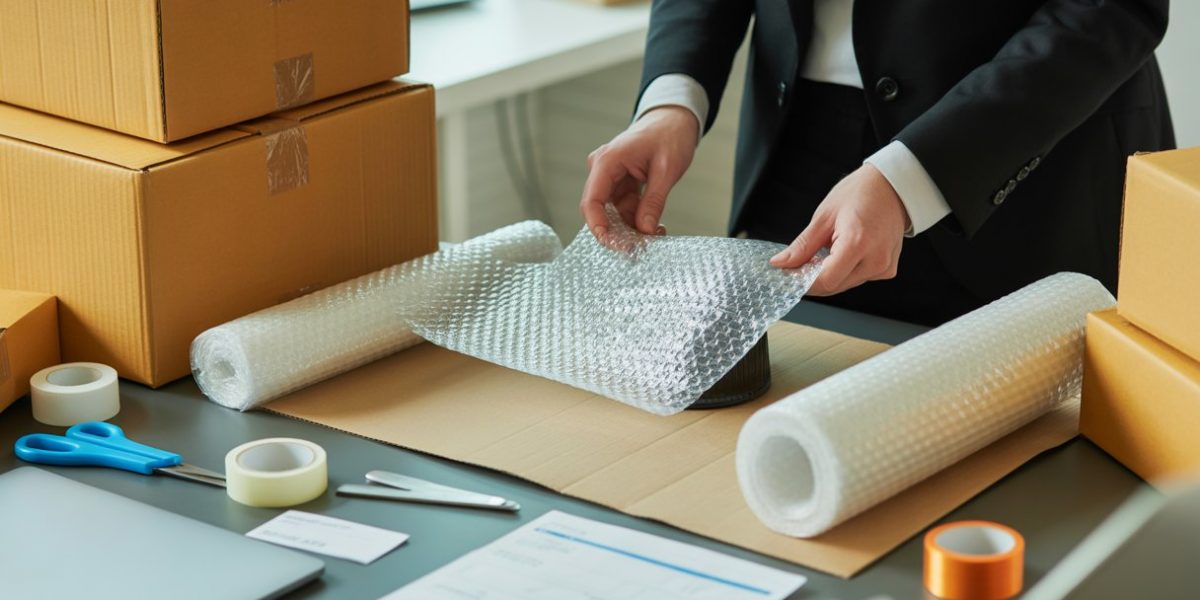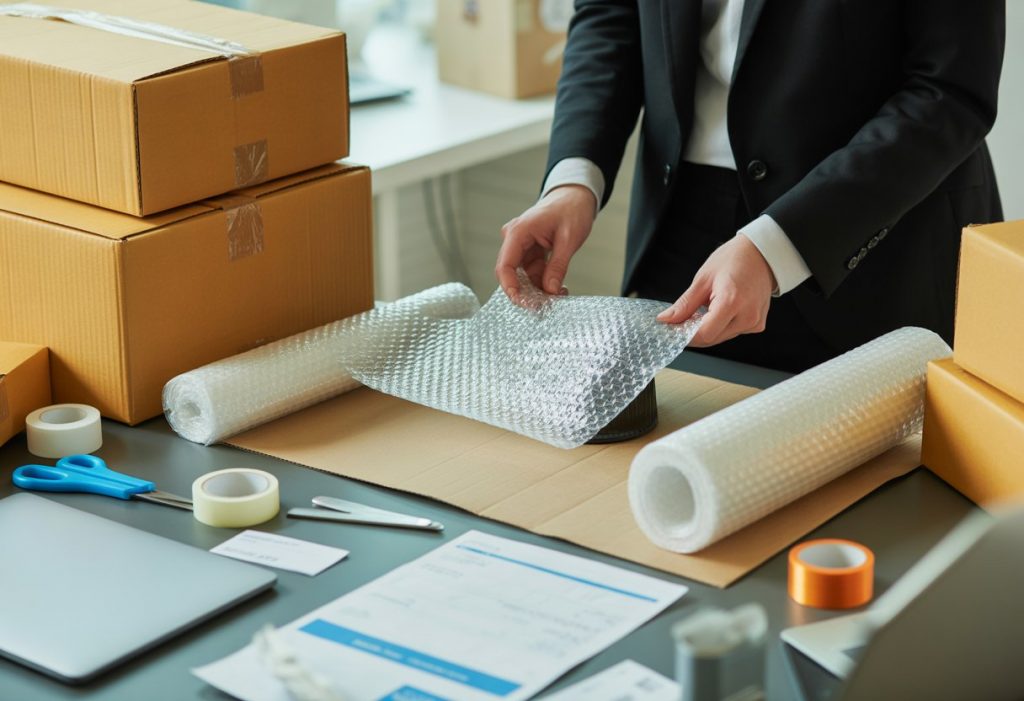Sending a parcel can feel risky, especially when it contains something valuable or important. Whether shipping products for business or sending gifts to loved ones, everyone worries about damage, loss, or delays during transit.
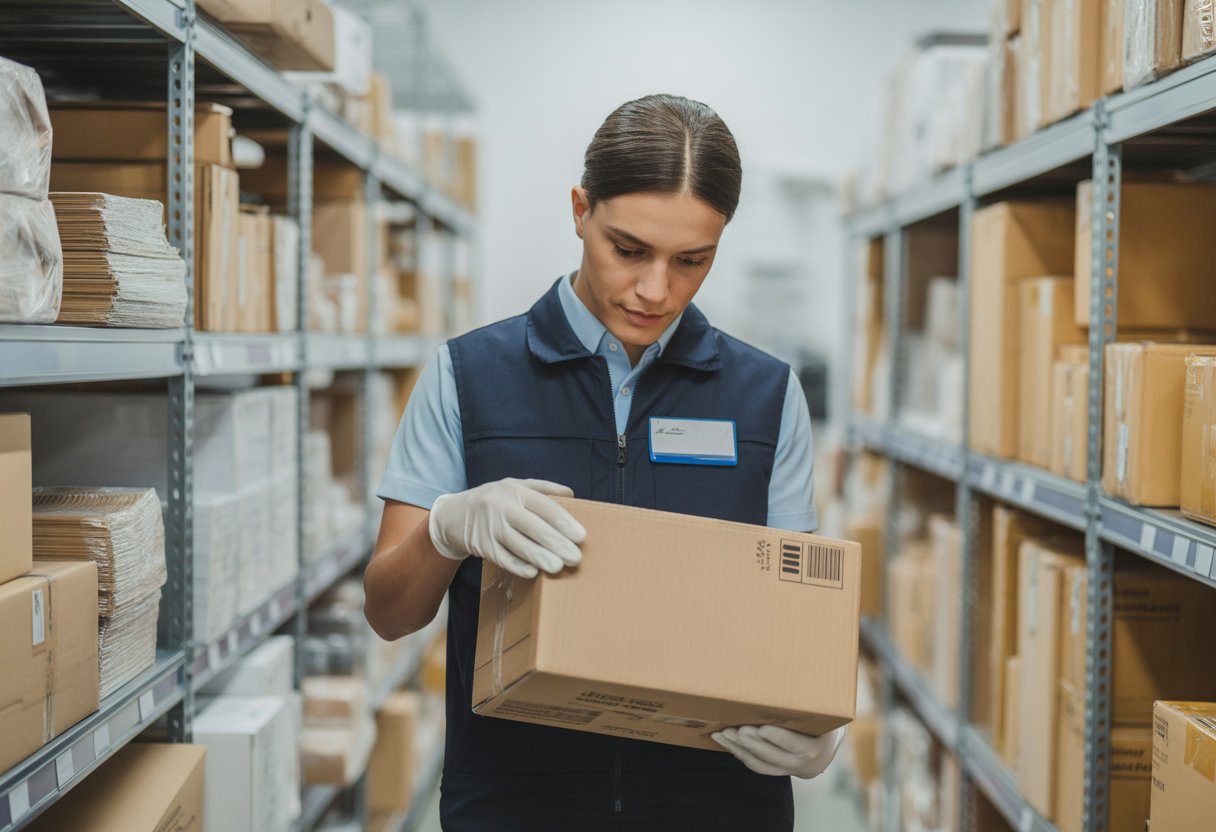
The key to safe package delivery lies in choosing the right courier service, proper packaging techniques, and active monitoring throughout the shipping process. Most delivery problems can be prevented with the right preparation and knowledge.
This guide covers everything needed to protect parcels from collection to final secure delivery. From selecting reliable courier services to mastering packaging methods and handling unexpected challenges, these expert-backed strategies will help ensure packages reach their destination safely every time.
Choosing the Right Courier Service
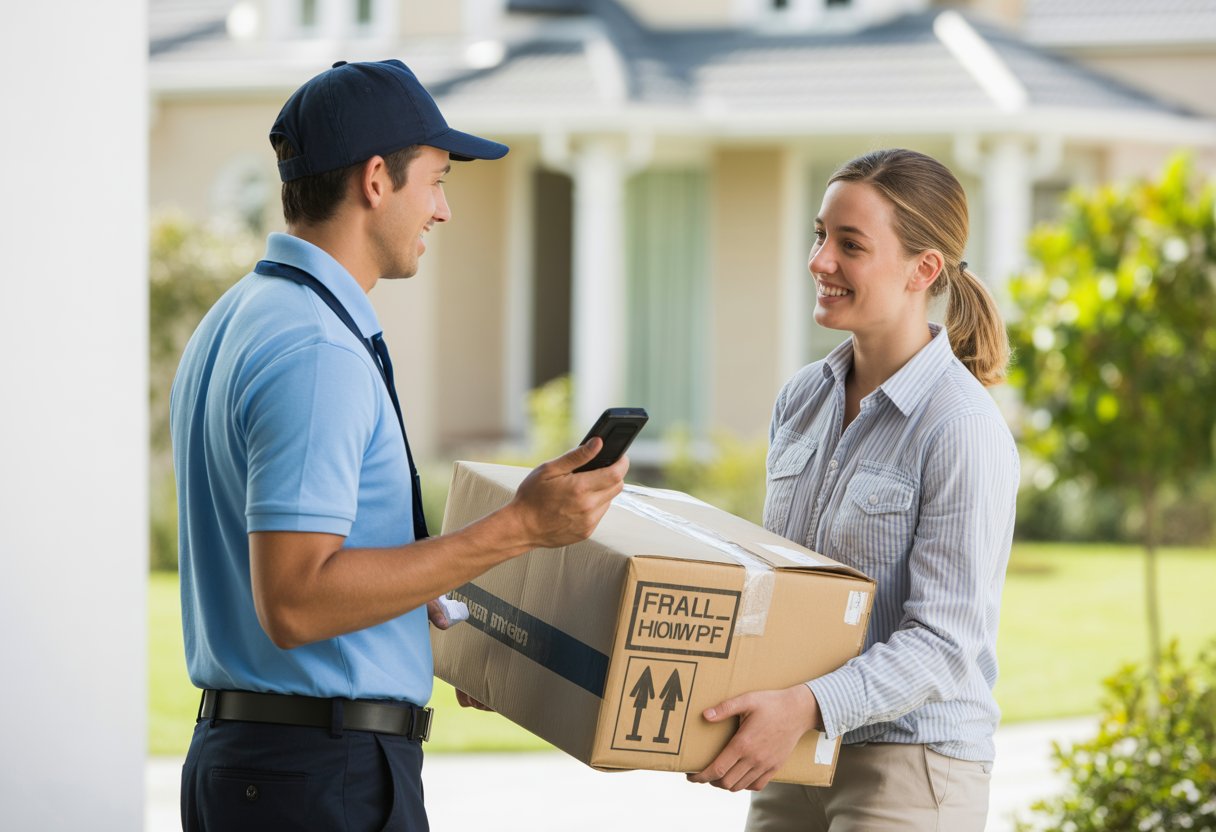
A reliable courier service protects packages through proper handling, insurance coverage, and proven delivery methods. The right choice depends on the company’s track record, protection policies, and service options that match specific shipping needs.
Evaluating Trustworthiness and Reputation
Customer reviews provide valuable insights into a courier’s reliability and service quality. Check multiple review platforms to see consistent patterns in feedback about delivery times and package handling.
Look for couriers with established business histories and proper licencing. Companies that have operated for several years typically have better systems in place for handling problems.
Key reputation indicators include:
- Consistent positive customer feedback
- Clear contact information and customer service
- Proper business registration and licences
- Professional website with detailed service information
Ask about their package tracking systems. Trustworthy courier services offer real-time tracking updates throughout the delivery process.
Check if they handle complaints professionally. Contact their customer service with questions to test response times and helpfulness.
Understanding Insurance and Liability
Standard courier liability often covers only basic compensation for lost items. This coverage usually equals a small amount per kilogram rather than the item’s actual value.
Purchase additional insurance for valuable items. Most courier services offer extended coverage options that protect the full declared value of packages.
Read the terms carefully before shipping. Some couriers exclude certain items from coverage, such as electronics, jewellery, or fragile goods.
Insurance considerations:
- Declared value limits – Maximum compensation available
- Excluded items – What the policy won’t cover
- Claim procedures – How to file if something goes wrong
- Premium costs – Additional fees for extra protection
Document package contents with photos before shipping. This evidence helps support insurance claims if items arrive damaged or missing.
Comparing Delivery Types and Timeframes
Same-day secure delivery suits urgent documents or time-sensitive items but costs significantly more than standard services. This option works best for local deliveries within city limits.
Next-day delivery balances speed with reasonable pricing for most business needs. It provides reliable timing without the premium costs of same-day service.
Standard delivery takes 2-5 business days but offers the most economical rates. Choose this for non-urgent items where cost matters more than speed.
Delivery comparison:
| Service Type | Timeframe | Best For | Cost Level |
|---|---|---|---|
| Same-day | Within 24 hours | Urgent items | Highest |
| Next-day | 1 business day | Important documents | Medium |
| Standard | 2-5 business days | Regular packages | Lowest |
Consider the courier’s coverage area for your delivery location. Some services only operate in major cities, whilst others cover rural areas with longer delivery times.
Preparing Your Parcel for Shipment

Proper parcel preparation requires careful selection of packaging materials, accurate addressing with complete contact details, and precise measurements. These steps form the foundation of safe package delivery.
Selecting Appropriate Packaging
Choose a box that fits your items snugly without being too tight. The box should be strong enough to protect contents during handling.
Use new or like-new boxes whenever possible. Worn boxes may fail during transport.
Essential packing materials include:
- Bubble wrap for fragile items
- Packing paper or newspaper
- Foam peanuts or air pillows
- Strong packing tape (at least 2 inches wide)
Fill empty spaces inside the box to prevent items from moving. Shake the sealed box gently – nothing should rattle or shift.
Wrap fragile items individually before placing them in the box. Use extra cushioning around corners and edges where damage often occurs.
Seal all box seams with tape, including the centre seam and edges. Apply tape in an “H” pattern on both top and bottom for maximum security.
Addressing and Labelling Correctly
Write addresses clearly in black ink or print labels using a standard font. Ensure all text is legible and properly sized.
Include complete recipient details: full name, house number, street name, town, county, and postcode. Add the recipient’s phone number when possible.
The return address must contain:
- Your full name or business name
- Complete address
- Contact numbers (mobile or landline)
Place the delivery address in the centre of the package’s largest face. Position the return address in the top left corner.
Remove or cover old shipping labels completely. Multiple labels confuse sorting systems and delay delivery.
Use waterproof labels or cover paper labels with clear tape. This prevents smudging if the package gets wet.
Measuring Weight and Dimensions
Measure your package after it’s fully packed and sealed. Use a ruler or measuring tape for length, width, and height.
Record measurements to the nearest centimetre. Include any protruding parts like handles or clips in your measurements.
Weigh the package on accurate scales. Kitchen scales work for lighter items, but postal scales give more precise readings.
Measure packages this way:
- Length: longest side
- Width: shortest side
- Height: remaining dimension
Double-check your measurements before booking courier services. Incorrect dimensions may result in extra charges or delivery delays.
Some couriers charge by volumetric weight rather than actual weight. Calculate this by multiplying length × width × height, then dividing by the courier’s volumetric factor.
Essential Packaging Materials and Techniques
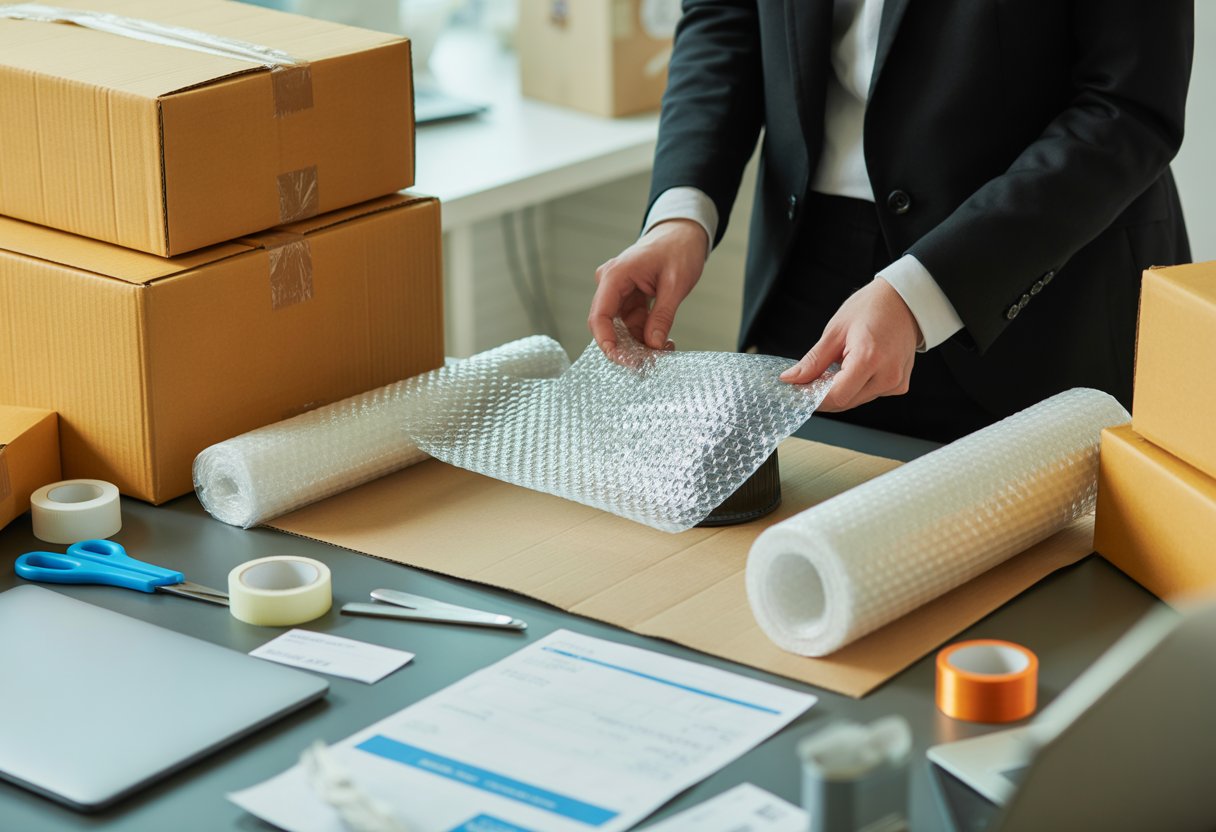
The right packaging materials and proper techniques form the foundation of safe shipping. Quality sturdy boxes, protective bubble wrap, strong packing tape, and space-filling packing peanuts work together to shield items from damage during transport.
Using Sturdy Boxes for Protection
Sturdy boxes serve as the first line of defence against shipping damage. Cardboard boxes with double-wall construction offer superior strength compared to single-wall options.
Choose boxes that match the size of the items being shipped. Oversized boxes allow too much movement, whilst undersized boxes create pressure points that can cause damage.
New boxes provide better protection than reused ones. Old boxes may have weakened corners or compromised structural integrity from previous use.
Box weight limits must be respected to prevent bottom failure during handling. Most standard boxes support 20-30 kilograms safely.
The box should close flat without bulging sides or gaps at the seams. Proper fit ensures the box maintains its protective shape throughout shipping.
Securing Items with Bubble Wrap
Bubble wrap creates a protective barrier that absorbs shock and prevents scratches. The air-filled bubbles compress upon impact, distributing force away from fragile items.
Wrap individual items completely, ensuring all surfaces receive coverage. Use enough layers so the bubbles don’t pop easily when pressed.
Bubble size matters for different items:
- Small bubbles (6-12mm) work best for lightweight, delicate items
- Large bubbles (25mm) provide better cushioning for heavier objects
Secure the bubble wrap with tape to prevent unwrapping during transport. Pay special attention to corners and edges where damage commonly occurs.
Anti-static bubble wrap prevents damage to electronic components. Standard bubble wrap can create static electricity that harms sensitive devices.
Applying Packing Tape Properly
Quality packing tape keeps boxes sealed and maintains their structural integrity. Use tape that’s at least 5cm wide for adequate holding power.
Apply tape in an “H” pattern on box seams. Run strips along the centre seam and both edges where the flaps meet.
Avoid these common mistakes:
- Using insufficient tape coverage
- Applying tape to dusty or damaged surfaces
- Stretching tape too tightly during application
Press tape down firmly to ensure proper adhesion. Run a finger along the edges to eliminate air bubbles that weaken the seal.
Reinforcement tape on corners adds extra strength for heavy packages. This prevents the box from splitting at stress points during handling.
Filling Spaces with Packing Peanuts
Packing peanuts eliminate empty space that allows items to shift during transport. They distribute weight evenly and provide cushioning from all directions.
Fill boxes completely so items cannot move when shaken. The packing peanuts should compress slightly but not be overpacked.
Types of packing peanuts include:
- Expanded polystyrene (traditional foam)
- Biodegradable starch-based options
- Recycled paper alternatives
Layer packing peanuts throughout the box, not just on top. Place a base layer, position the wrapped item, then fill remaining spaces.
Antistatic packing peanuts protect electronic items from static discharge. Standard foam peanuts can generate electricity that damages circuit boards.
Tracking and Monitoring Your Delivery
Modern tracking systems give customers real-time updates about their packages and direct access to support teams. These tools help ensure parcels reach their destination safely whilst providing peace of mind throughout the delivery process.
Utilising Live Tracking Services
Live tracking services show exactly where a package is during transit. Most major couriers offer this feature through websites or mobile apps.
Customers receive a unique tracking number when they ship an item. This number provides access to real-time location data and estimated delivery times.
Many UK delivery companies use GPS trackers in their vans. This technology allows precise location updates throughout the journey.
Key benefits of live tracking include:
- Real-time location updates
- Accurate delivery estimates
- Proof of delivery notifications
- Route information
Some services send automatic text messages or emails when packages reach key milestones. These alerts keep recipients informed without checking tracking systems manually.
Modern tracking systems also monitor package conditions during transport. Temperature-sensitive items receive special attention through environmental monitoring.
Interpreting Tracking Updates
Package tracking uses standard terms that customers should understand. Each update shows the parcel’s current status and location.
“Out for delivery” means the package is on the delivery vehicle. It should arrive that day unless delays occur.
“In transit” indicates the parcel is moving between facilities. This status is normal and shows progress towards the destination.
“Processing at facility” means the package is being sorted at a depot. This step usually takes 1-2 hours before the next update appears.
“Delivery attempted” occurs when no one is available to receive the package. The courier will try again or leave instructions for collection.
Some tracking systems show detailed route information. This includes which depots the package has visited and departure times.
Delays sometimes happen due to weather or high volumes. Tracking systems usually explain these situations with specific messages.
Communicating with Customer Support
Customer support teams can resolve tracking issues and provide additional information. Most courier companies offer multiple contact methods.
Live chat is often the fastest way to get help. Support agents can check detailed tracking information and provide updates not shown online.
Phone support works well for complex issues. Representatives can investigate problems and coordinate with delivery teams directly.
Many companies offer email support for non-urgent queries. This method provides written records of communications about packages.
Social media channels often provide quick responses during business hours. Twitter and Facebook support teams can track packages and answer questions.
When contacting support, customers should provide their tracking number and delivery address. This information helps agents locate packages quickly.
Support teams can arrange redelivery attempts or redirect packages to different addresses. They can also investigate missing parcels and process compensation claims when needed.
Handling Delivery Challenges and Returns
Delivery complications can disrupt even the best-planned shipments, requiring proactive strategies for courier communication and recipient coordination. Clear return procedures protect both senders and recipients when packages need to be sent back.
Providing Special Instructions to Couriers
Clear delivery instructions help courier services navigate complex delivery situations successfully. These details should be included when booking the shipment or added to the delivery address section.
Essential instructions to provide:
- Access codes for buildings or gates
- Alternative delivery locations such as reception desks or neighbour preferences
- Specific handling requirements for fragile or valuable items
- Time restrictions when deliveries cannot be accepted
Most courier services allow customers to add notes during the booking process. These instructions travel with the package and help drivers make successful first-time deliveries.
Contact the courier service directly for unusual delivery requirements. This ensures they can accommodate special needs before attempting delivery.
Ensuring Someone is Available for Receipt
Failed delivery attempts create delays and additional costs for all parties involved. Planning for successful receipt requires coordination between sender and recipient.
Confirm the recipient’s availability before scheduling delivery. Many courier services provide estimated delivery windows that help recipients plan accordingly.
Alternative receipt options include:
- Authorising neighbours to accept packages
- Arranging workplace delivery during business hours
- Using courier service collection points or lockers
- Scheduling specific delivery appointments
Some courier services offer SMS or email notifications with tracking updates. These alerts give recipients advance notice of incoming deliveries.
Valuable packages often require signature confirmation. Recipients should carry identification and be prepared to sign for these items personally.
Arranging for Safe Returns
Return procedures should be established before shipping to handle damaged, incorrect, or unwanted items efficiently. A clear return address must be included on all packages.
Return process essentials:
- Return authorisation numbers when required by the sender
- Original packaging preservation for potential returns
- Prepaid return labels for customer convenience
- Time limits for return eligibility
The return address should include complete contact details and any special handling instructions. This information helps courier services process returns quickly and accurately.
Document the package condition upon receipt with photographs. This evidence supports return claims if items arrive damaged or incomplete.
Many courier services offer return collection services, eliminating the need for recipients to visit drop-off points. This convenience encourages proper return procedures and maintains customer satisfaction.
Frequently Asked Questions
Many people have common concerns about proper packaging techniques, transit handling, tracking methods, and insurance options. These questions help address the most important aspects of safe parcel delivery.
What are the best practices for packing fragile items for shipment?
Fragile items need extra cushioning and protection. Use bubble wrap to wrap each item individually, creating at least two inches of padding around all sides.
Choose a sturdy box that allows for additional padding material. Fill empty spaces with packing peanuts, crumpled paper, or foam inserts to prevent movement during transport.
Mark the package clearly with “FRAGILE” labels on multiple sides. Place these stickers near the top and sides where handlers can easily see them.
Double-boxing provides extra protection for very delicate items. Put the wrapped item in a smaller box, then place that box inside a larger one with more cushioning material.
How can you ensure that your parcel is handled properly during transit?
Select a reputable courier service with good handling practices. Research their track record for damaged packages and customer reviews.
Use clear handling instructions on the package exterior. Labels such as “This Way Up” or “Handle with Care” help workers know how to treat your parcel.
Proper packaging reduces the risk of damage even if handlers are not careful. Strong boxes and adequate padding protect items from rough treatment.
Consider paying for premium services that offer gentler handling. These services often cost more but provide better care for valuable or delicate items.
What materials are recommended for securing items within a package?
Bubble wrap provides excellent cushioning for most items. It absorbs shock and prevents scratches during transport.
Packing peanuts fill empty spaces effectively and prevent items from shifting. They work well for irregular-shaped objects.
Strong packing tape secures all seams and closures. Use tape that is at least two inches wide for better adhesion.
Foam inserts custom-fit around specific items. They offer superior protection for electronics and other valuable goods.
Crumpled newspaper works as budget-friendly filler material. However, it provides less protection than professional packing materials.
Is insurance necessary for shipping valuable goods, and how do you obtain it?
Insurance protects against financial loss if parcels get damaged, lost, or stolen. Most courier services offer basic coverage, but it may not cover the full value of expensive items.
Calculate the replacement cost of your items before shipping. This helps determine how much insurance coverage you need.
Purchase additional insurance through your courier service when the basic coverage is insufficient. The cost is usually a small percentage of the declared value.
Some home insurance policies cover items during shipping. Check with your insurance provider before buying additional courier insurance.
Keep receipts and documentation of the item’s value. These documents are essential for making insurance claims if problems occur.
What should you consider when selecting a courier service for safe delivery?
Research the courier’s reputation for safe handling and on-time delivery. Read customer reviews and check their claims process for damaged items.
Compare delivery timeframes and choose services that match your urgency needs. Faster services often provide better handling.
Look at tracking capabilities and customer support quality. Good tracking systems help monitor your package throughout its journey.
Consider the courier’s coverage area and delivery options. Some services offer special handling for fragile or valuable items.
Compare pricing, but remember that the cheapest option may not provide the best protection. Balance cost with the value of your items.
How can you track your package to confirm its safe arrival at the destination?
Most courier services provide tracking numbers when you ship packages. Use these numbers on the company’s website or mobile app to monitor progress.
Set up delivery notifications through email or text messages. These alerts inform you when packages are collected, in transit, and delivered.
Some services offer real-time GPS tracking that shows your package’s exact location. This feature provides more detailed monitoring.
Confirm delivery with the recipient once tracking shows the package has arrived. This ensures someone actually received your parcel safely.
Keep tracking information until you confirm safe delivery. This documentation helps resolve any disputes about missing packages.

